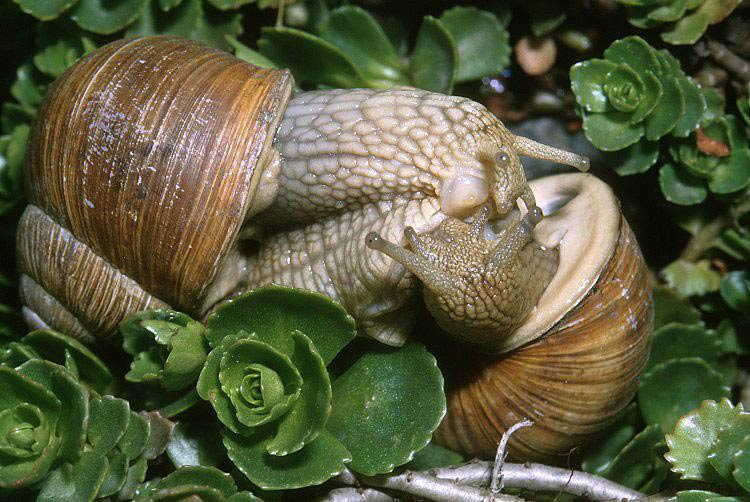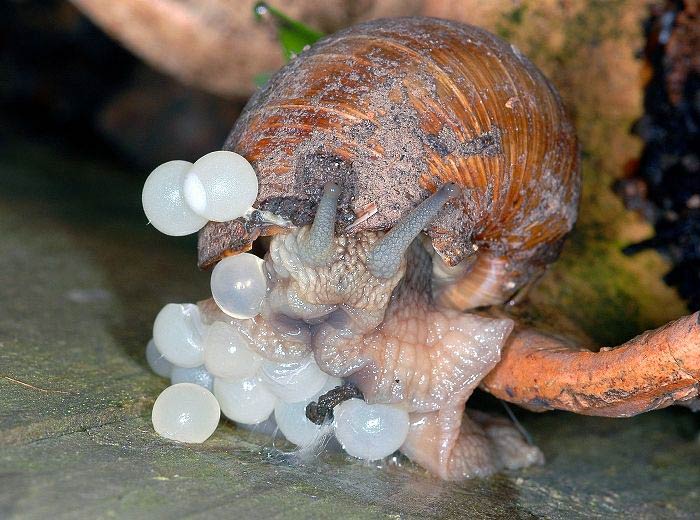Helix spp.
|
Helix lucorum. (Photo: © H.G. Lee, Jacksonville) |
|
Helix lucorum. (Photo: © M. Manas, Wikipedia) |
|
Helix lucorum. (Photo: © M. Manas, Wikipedia) |
|
Helix pomatia. (Photo: © V. Motycka, www.biolib.cz) |
|
Helix pomatia: juvenile. (Photo: © V. Motycka, www.biolib.cz) |
|
Helix pomatia. (Photo: © V. Motycka, www.biolib.cz) |
|
Helix pomatia: laying eggs. (Photo: © V. Motycka, www.biolib.cz) |
Family
Helicidae
Species
Helix pomatia Linnaeus, 1758
H. lucorum Linnaeus, 1758
H. aperta Born, 1778
Common name
Roman snail, Edible snail, Vineyard snail
Helix aperta: Burrowing snail, Green snail
Description
H. pomatia: Helix pomatia has a large shellShell:
A hard, inflexible, calcareous or chitinous structure that vary in size and may either completely encasing the animal, covering some part of it or be internal.
that can attain a heightHeight:
The height of the shell is a measure of the distance between the apex and the most basal part of the shell OR the measurement taken from the apex of the shell to the base, when measured parallel to the axis of the shell.
of 30-50 mm and a widthWidth:
The width of the shell is the maximum distance across the shell (including the aperture).
of 32-50 mm. There are a total of 5-6 whorlsWhorls:
Pleural of whorl. A whorl is a complete spiral turn/growth of the shell of a mollusc. The whorls are counted from the apex outwards.
. The thin shellShell:
A hard, inflexible, calcareous or chitinous structure that vary in size and may either completely encasing the animal, covering some part of it or be internal.
of this snail is globoseGlobose:
Shell shape: to be roughly spherical or globular in shape.
with a wrinkled surface, giving the appearance of faint spiralSpiral:
Directional term: direction of the coils of the whorls of a shell; opposite of axial.
lines. The shellShell:
A hard, inflexible, calcareous or chitinous structure that vary in size and may either completely encasing the animal, covering some part of it or be internal.
has a brownish color often classified as chamois. This chamois color is often interrupted by wide cinnamon-brown stripes. The stripes may be either distinct or ill-defined. The apertureAperture:
The major opening of a shell that the body of the animal may be retracted.
is large with a slightly expanded pecan brown lipLip:
The margin of the aperture, which may be sharp or thickened depending upon the species (Also see apertural lip).
that is broadly reflected at the collumela, partially covering the umbilicusUmbilicus:
A navel-like indentation or depression in the center of the shell. It may be described as open (inside of columella visible), partially closed (partly covered by base of aperture) or completely closed (not visible). The width of the umbilicus is a measure of its greatest diameter.
.
H. lucorum: The thick shellShell:
A hard, inflexible, calcareous or chitinous structure that vary in size and may either completely encasing the animal, covering some part of it or be internal.
of this species will get as high as 55 mm, with 4.5-5 rapidly increasing whorlsWhorls:
Pleural of whorl. A whorl is a complete spiral turn/growth of the shell of a mollusc. The whorls are counted from the apex outwards.
. The compressed, spherical shellShell:
A hard, inflexible, calcareous or chitinous structure that vary in size and may either completely encasing the animal, covering some part of it or be internal.
has a distinct apexApex:
The tip of the spire of a shell.
. The shellShell:
A hard, inflexible, calcareous or chitinous structure that vary in size and may either completely encasing the animal, covering some part of it or be internal.
has a white background with dark-brown, irregular, vertical bands.
H. aperta: This species has a diameter of approximate 31 mm, with 4 rapidly increasing whorlsWhorls:
Pleural of whorl. A whorl is a complete spiral turn/growth of the shell of a mollusc. The whorls are counted from the apex outwards.
. This species is not banded or striped. The baseBase:
This is the lower or underside of the shell; opposite of apical.
color is olive-brown to greenish. The shellShell:
A hard, inflexible, calcareous or chitinous structure that vary in size and may either completely encasing the animal, covering some part of it or be internal.
is thin-walled and translucentTranslucent:
Allows light to pass through but prevents the ability to see distinct objects.
.
Note: The surface sculpturing of the shellShell:
A hard, inflexible, calcareous or chitinous structure that vary in size and may either completely encasing the animal, covering some part of it or be internal.
can be used to distinguish between Helix spp. and Cornu aspersum. The shellShell:
A hard, inflexible, calcareous or chitinous structure that vary in size and may either completely encasing the animal, covering some part of it or be internal.
of Cornu aspersum is characteristically wrinkled, while the shellShell:
A hard, inflexible, calcareous or chitinous structure that vary in size and may either completely encasing the animal, covering some part of it or be internal.
surface of Helix species lack wrinkles.
Native range
Central and Southeastern Europe, and the Mediterranean region
Distribution
North America:
- U.S.: Michigan, Wisconsin
Europe
Other: Mediterranean region
Ecology
This group of species can be found in greenhouses, grassy areas, forests, gardens and orchards where they may attain pest status. Their longevity is approximately 5 years, although specimens of H. pomatia have been documented to live for over 20 years.
Synonyms
Helix aperta:
- Cantareus apertus (Born, 1778)
H. lucorum:
- Helix taurica Krynicki, 1833
- Helix radiosa Rossmassler, 1838
- Helix taurica mut. martensi O. Boettger, 1883
- Helix ancyrensis haussknechti Kobelt, 1906
References
Anderson 2005Anderson 2005:
Anderson, R. 2005. An annotated list of the non-marine Mollusca of Britain and Ireland. Journal of Conchology 38: 607-637.; Boycott 1934; Horsák et al. 2004Horsák et al. 2004:
Horsák, M., L. Dvorák and L. Juricková. 2004. Greenhouse gastropods of the Czech Republic: current stage of research. Malacological Newsletter 22: 141-147.; Kantor et al. 2009Kantor et al. 2009:
Kantor, Y.I., M.V. Vinarski, A.A. Schileyko and A.V. Sysoev. 2009. Catalogue of the continental mollusks of Russia and adjacent territories. Version 2.1. (Accessed online July 20, 2010); Kerney et al. 1979Kerney et al. 1979:
Kerney, M.P., R.A.D. Cameron and G. Riley. 1979. A field guide to the land snails of Britain and North-west Europe. Collins, London. pp. 288.; Pilsbry 1939Pilsbry 1939:
Pilsbry, H. A. 1939. Land Mollusca of North America north of Mexico vol. I part 1. Academy of Natural Sciences, Philadelphia. pp. 1-574.; Yildirim et al. 2004Yildirim et al. 2004:
Yildirim, M.Z., U. Kebapçl and B.A. Gümüs. 2004. Edible snails (Terrestrial) of Turkey. Turkish Journal of Zoology 28: 329-335.








